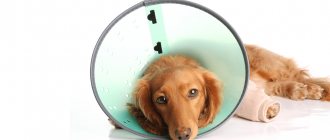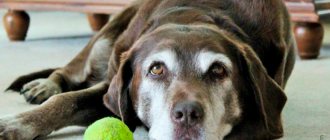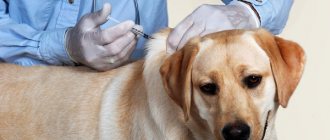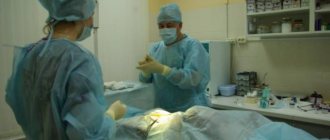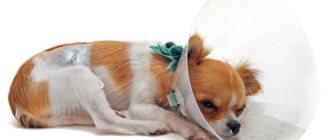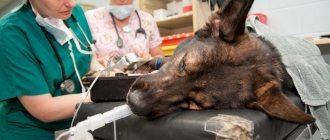Almost all pet owners face surgery. The list of the most common includes castration and sterilization. Regardless of the task, surgery is performed with mandatory suturing. If the threads used are not absorbable, then after the postoperative wound has healed, they must be removed. As a rule, this procedure is performed by a veterinarian, but sometimes circumstances force you to solve the problem yourself. If you follow the step-by-step instructions, even a beginner can handle suture removal.
Features of suture material
According to the method of location, seams are divided into internal and external. The former are used to connect cut tissues: muscles, blood vessels, subcutaneous tissue. They cannot be seen during external examination, so they try to reduce possible complications with high-quality material. In 90% of cases, internal sutures are placed with absorbable sutures. The external version is often made from synthetic threads. This is what you have to remove yourself. If they remain in the body for a long time, the threads begin to be rejected, and suppuration occurs.
Preparatory measures and step-by-step removal of sutures
If the dog owner is not sure how the dog will behave when the stitches are removed, they should use a muzzle and wrap a towel around the muzzle for strength. Sometimes a muzzle is not enough, so more often they use compacted material, for example, a towel. This option is used as a “mask”, the ends of which are wound behind the muzzle and firmly connected.
There are often cases where the wound has healed, but the threads bring discomfort to the dog - the area itches, and the animal tries to bite them off. It is important to constantly monitor and ensure that the pet does not chew them out, otherwise the operation will need to be done again. Let's analyze the step-by-step removal of sutures after surgery on a dog:
- First of all, you need to make sure that the stitches are healed and there is no swelling.
- This area must be soaked in advance. solution for resorption of crusts.
- Approximately a day before the planned action, the area should be smeared with ointment (greasy) to soften and slip off the threads.
You can proceed to the next step if all of the above points are completed correctly. Immediately before releasing the sutures, it is necessary to treat with iodine. Next, you need to choose scissors with flat ends (not too thin).
The animal is held steadily. When a small breed dog can be swaddled. It is preferable to place the pet on its side. Then you need to find long threads, press them with the fingers of your left hand, pulling them a little to create a vertical position.
Next, cut the thread between the skin and the knot. The instrument is inserted exclusively from the outside of the nodule. When the thread is cut entirely, you need to lightly press on the skin close to the seam (with the finger of your right hand), and carefully pull out the long threads with your left hand. When both threads are cut, use tweezers. To do this, take the thread by the edge and carefully pull it out.
The final stage consists of treating the area with an iodine solution. Thus, you have learned about removing stitches from a dog.
How to care for sutures after surgery
After surgery, the dog needs constant care. Typically, sutures should be treated for two weeks until the wound heals completely. Naturally, after surgery, the recovery time may last longer. To learn how to care for your seams, use the following tips. Thus, caring for an animal’s sutures after surgery consists of several important points:
Inspect the wound at least 2 times a day. The wound must always be clean, and the edges must be connected. There may be slight redness and bruising in the area of the operation, as well as pinkish fluid oozing from the wound. When an animal constantly licks or tries to bite off stitches, it is recommended to wear a protective collar. This way, the dog will not be able to reach the area and the absence of inflammation and suture divergence is guaranteed.
Once a day, it is necessary to treat the area with an antiseptic without ethanol. You also need to monitor the place where the dog rests, since the area must always be clean and dry, without moisture or dirt. This is how you can prevent suppuration and infection from entering the wound.
You have become familiar with caring for sutures, and you also already know when to remove your dog’s sutures. But prohibited manipulations for caring for an animal should also be outlined:
- For 1-2 weeks, the dog should be on a leash when walking so as not to make sudden movements, otherwise the seams may come apart. Avoid contact of your pet with other animals.
- Washing your pet is also prohibited. In particular, make sure that the stitches do not become wet.
- It is highly not recommended to treat the area after surgery with any creams, peroxide, or alcohol, which will only slow down the healing process.
- Avoid the formation of bedsores.
Benefits of removing stitches at home
Removing stitches for a dog after surgery is not as difficult as it initially seems. Ideally, it is recommended to consult a veterinarian before the procedure. After examining the four-legged patient, he will confirm that the wound has healed and will not come apart when the threads are removed. Additionally, the doctor will explain how to remove the dog’s stitches at home. After receiving the conclusion and detailed instructions, you can proceed with your planned actions without fear of possible consequences.
As a rule, you will have to resort to the help of a veterinarian in two situations: after ear cropping and after eye surgery. This cannot be done without pain, so sometimes animals require anesthesia.
Undoubtedly, the services of doctors at a veterinary clinic are more reliable and faster. But in some situations, seeing a doctor is impossible. A lot of people live in the region, so it’s hard for them to get out to the big city. In addition to hopelessness, other advantages of removing stitches at home are also an important factor. These include:
- Protection against infection. Not only healthy but also sick animals are brought to the clinic. In the postoperative period, immunity decreases. The dog is more vulnerable to infections than usual. The problem can be solved by making an appointment for a specific time, but even so, appointment hours are often shifted due to the previous patient taking too long to examine.
- Reducing the stress factor. The veterinary clinic is associated with pain. Most animals experience severe nervous tension when they find themselves within the walls of this institution. Because of this, even simple manipulations are equated to the ninth circle of hell. Performing the same actions on familiar territory is perceived more adequately by any owner. If a trip to the veterinary clinic is one of the stressors for your pet, then it is better to get rid of unnecessary worries and learn how to remove your dog’s stitches yourself. Otherwise, there is a high probability of secondary infection due to stress.
- Saving. Independent work, although it takes time, is absolutely free. If you are confident in your abilities, set aside money for more important things.
After the stress of spaying and neutering, the dog will be grateful for the absence of strangers smelling of medicine. Before carrying out the procedure, it is necessary to prepare instruments, find an assistant and make sure that the upcoming operation is safe.
What needs to be done before the procedure?
Examine the wound or incision for signs of healing or infection. As a rule, the sutures are removed after waiting at least ten days after the operation. If the incision gapes, or the edges of the skin in this place have not fused with each other, show the dog to the veterinarian, do not remove the sutures, since in this case such a procedure is far from the best idea. How can you accurately determine when you need to urgently take your dog to the vet?
Symptoms of infection include exudation, a foul odor, and severe redness and swelling of the surgical area. If you see any of the above, immediately take your dog to the doctor. In this case, it is better not to think about how to remove the stitches at home, as you will simply kill your pet.
How can you tell if a wound has healed?
Not only early, but also late removal of suture material is considered dangerous. In the first case, there is a high probability of wound divergence, in the second - ingrowth and suppuration of the threads. As a rule, at the end of the operation, the veterinarian announces a conditional healing date. On average, healing is about 10-14 days and depends on the location of the surgical intervention:
- neck and head – 5-7 days;
- chest, paws and peritoneum – 10-14 days.
In addition to the area operated on, age affects the healing rate. Tissue regeneration in puppies is higher than in adults and older animals.
Focus on the date announced by the doctor, but do not forget to monitor external changes. After 4-5 days, the formation of granulation is acceptable - a painless ball under the skin. It will resolve on its own a little later. If the edges of the incision have become almost invisible, and the nearby skin is not red or inflamed, proceed to removal.
You should postpone the procedure and seek help from a doctor only if the following symptoms appear:
- unpleasant odor;
- increased redness;
- discharge of pus;
- presence of bleeding or blood crusts;
- increase in local temperature;
- formation of swelling and inflammation.
All of these symptoms occur when an infection occurs and are fraught with an abscess with subsequent blood poisoning. If you find at least one of them, give up independent actions in favor of visiting a veterinary clinic. Pulling out threads during the inflammatory process is more difficult due to pain. Monitor your pet carefully to avoid infection.
What will be required for the procedure?
Here is a list of things that you will definitely need to remove stitches from your pet:
- Surgical scissors with rounded edges (or similar models).
- Surgical tweezers. It has teeth on its jaws that are convenient for gripping the seam.
- Cotton swabs.
- Disinfectant (but not alcohol or concentrated hydrogen peroxide).
- Gauze or a clean towel.
Preparation for the procedure
Arrange in advance to meet with a friend who is willing to take on the role of nurse, or enlist the help of a family member. The dog must know him so as not to feel nervous about the appearance of a stranger. The assistant’s tasks will include holding the four-legged patient until the end of the manipulations. You won't be able to handle the animal alone. You will either injure him or cause him stress by tying him up. As an exception, we can name representatives of small breeds, but even here it is better to have two free hands, since removing a dog’s stitches is a little more difficult than the usual hygiene procedure.
Caring for your dog immediately after surgery
If an animal is sterilized in a trusted veterinary clinic and is performed by a veterinary surgeon with extensive experience, then most often this procedure occurs without any complications.
Anesthesia has a strong effect on the dog's body. It slows down the animal's body functions, including metabolism. There is a violation of heat exchange, which is why the pet begins to freeze, despite the normal temperature in the room.
Anesthesia also helps to lower the animal's pulse and slow down its breathing. Typically, awakening occurs within 2-8 hours after surgery. It is important to monitor all these indicators on the territory of the veterinary clinic; it is for such cases that our veterinary center has a post-operative hospital, in which the animal, under the supervision of doctors, will recover from the state of anesthesia, so do not rush to take your pet home immediately after the operation.
If you do take your pet home
The animal can only be placed on a flat surface, preferably on the floor, avoiding hills and protecting it from drafts.
In a state of anesthesia, a dog can empty its intestines and bladder naturally, so in addition to warm bedding, we recommend laying out an absorbent diaper.
Caring for sutures after surgery
Caring for sutures is an important stage of the postoperative period in a dog’s life, on which wound healing and the animal’s well-being depend.
That is why it is important to monitor the condition of the stitches, change bandages as directed by the doctor and treat with antiseptics.
After sterilization, the dog requires a special blanket. It allows you to change dressings quickly and without complications. However, animal owners should be wary if such manifestations occur as: pus in the suture area, inflammation, redness, painful condition of the animal, fever. In this case, it is important to contact a veterinarian as soon as possible.
If the stitches are created with special dissolving threads, there is no need to see a doctor for removal. However, in the case when the seam is made with ordinary threads, the help of an experienced veterinarian will definitely be needed to remove them after healing.
Instructions for removing suture material
It is enough to hold small breed dogs by the head, while larger dogs will have to hold their limbs. Pay special attention to the rear ones, since from fright the animal can injure itself and others during manipulations. They can be wrapped tightly with cloth or covered with a blanket.
Try to maintain contact with your pet at all times. Talk, scratch, do everything possible to shift attention away from unpleasant actions. Position your pet's head so that he cannot see the tools or actions being performed. Panic is not always associated with real pain. If your pet is afraid of having its nails trimmed, it will easily become horrified just by looking at the manicure set. Don't tempt fate.
After following all the preparatory steps, including treatment with saline solution, proceed to the main steps
:
1. Keep the tools in boiling water and treat with alcohol. Any dirt that gets inside will cause inflammation. The safer the devices used, the higher the chance of a successful operation. It is equally important to take care of the cleanliness of your hands. Wash them thoroughly under running water and soap.
2 Take a clean towel and soak it in warm water. Remove any dried blood or other debris remaining on the wound.
3. Soak a cotton pad with 3 percent hydrogen peroxide and apply to the cleaned wound. Look closely at the seam. It is divided into outer and inner parts. The first includes two ponytails and a knot, the second includes everything that is hidden from you and located under the skin.
4. Gently move each of the threads from the outside, grasping them with tweezers. After the wound heals, they stick to each other, preventing quick removal. Don't be afraid, the threads are foreign to the body, so they move easily under the skin. During manipulation, slight discomfort for the animal is possible.
5. Use scissors to pick up one of the knots and pull vertically. Cut the seam from the outside of the knot, holding one of the tails with tweezers. Remember that the tips of the tool must be rounded. Otherwise, the likelihood of scratching or causing a puncture wound with the sharp tip increases.
6. Monitor the dog's condition. If the four-legged patient begins to worry, take a break. Put down your tools and talk to your pet. Don't show pity or encourage fear. In this case, the dog will decide that the fears are justified and it will no longer be possible to finish what he started without consequences. Be confident and speak in a calm voice. Encourage your dog by shaking his paw or patting his rump. Convince him that the situation is under control and all worries are not justified. Veterinarians note that the pain threshold of animals is lower than that of humans. Remember that the pet squeals not from pain, but from ordinary fear. The success of the operation depends on your confidence.
Preparing to remove sutures, “packing” the dog
If you have even the slightest doubt about your dog’s complete complacency, then put a muzzle on him, and to be safe, wrap a towel around his muzzle. What about bulldogs and other brachycephalics? In this case, a kind of “mask” is made from a thick (but not too thick, otherwise you will suffocate) towel, the ends of which are placed behind the head and tied tightly.
Give your dog a couple of minutes during which to pet him and say something soothing. Believe me, removing stitches after a caesarean section is much easier for a calm pet who will not run away from her owner with muffled grumbling and squealing!
Place your pet in a comfortable but safe position. Small dogs can be held gently but firmly by the head with one hand. It is better to restrain larger animals with an assistant who will hold not only the head, but also the paws. Pay great attention to holding the hind limbs, as the dog can do a lot of things with them (tear out a pair of scissors with a piece of skin, for example). Here are a couple more tips:
- If the dog is calm, try talking to him while the sutures are being removed, scratch his belly, and distract him in every possible way from the unpleasant procedure.
- Try to buy the scissors that you plan to use for this at a specialized veterinary or medical store. Their curved and rounded tips are ideal for hooking and cutting sutures.
- Regardless of what day you removed the stitches (whether the wound has completely healed or not), you need to monitor the condition of the healed wound for at least a week. If traces of blood or, even worse, pus appear, immediately show your dog to a veterinarian.
Care after sterilization
Many novice dog breeders are concerned about what kind of stitch a dog should have after the sterilization procedure. In most cases, suture removal is not required, since modern materials promote rapid healing and dissolve on their own. The main thing is to keep the operated area clean and timely treatment.
To protect the seams from bacteria and mechanical damage, use a special blanket with ties on the back. Since the thin, breathable material quickly becomes dirty, the bandage should be changed once a day. The new blanket must be ironed and only then put on the dog. When treating seams with chlorhexidine, the device is not removed; it is enough to simply move it to the side by untying several tapes.
The animal may try to rip off the bandage in order to scratch or lick the cosmetic seam. This should not be allowed, as infection may enter the area undergoing surgery. In these cases, an Elizabethan collar is put on the dog.
Surgery on pets is quite common. Your dog may require removal of a benign or malignant tumor, neutering surgery, or other surgical intervention. What are the similarities between them? Seams. And after the postoperative wound heals, in many cases it is necessary to get rid of them. How to remove stitches from a dog? Our article is devoted to this issue.
